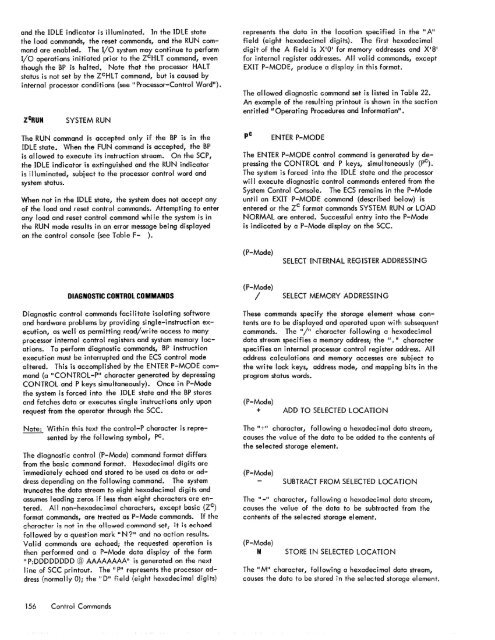1. xerox 560 computer system - The UK Mirror Service
1. xerox 560 computer system - The UK Mirror Service
1. xerox 560 computer system - The UK Mirror Service
Create successful ePaper yourself
Turn your PDF publications into a flip-book with our unique Google optimized e-Paper software.
and the IDLE indicator is illuminated. In the IDLE statethe load commands, the reset commands, and the RUN commandare enabled. <strong>The</strong> I/O <strong>system</strong> may continue to performI/o operations initiated prior to the ZCHLT command, eventhough the BP is halted. Note that the processor HALTstatus is not set by the ZCHLT command, but is caused byinternal processor conditions (see II Processor-Control Word").SYSTEM RUN<strong>The</strong> RUN command is accepted only if the BP is in theIDLE state. When the FUN command is accepted, the BPis allowed to execute its instruction stream. On the SCP,the IDLE indicator is extinguished and the RUN indicatoris illuminated, subject to the processor control word and<strong>system</strong> status.When not in the IDLE state, the <strong>system</strong> does not accept anyof the load and reset control commands. Attempti ng to enterany load and reset control command while the <strong>system</strong> is inthe RUN mode results in an error message being displayedon the control console (see Table F- ).represents the data in the location specified in the II A"field (eight hexadecimal digits). <strong>The</strong> first hexadecimaldigit of the A field is XIOI for memory addresses and X'8 1for internal register addresses. All valid commands, exceptEXIT P-MODE, produce a display in this format.<strong>The</strong> allowed diagnostic command set is listed in Table 22.An example of the resulting printout is shown in the sectionentitled ,rOperating Procedures and Information".pCENTER P-MODE<strong>The</strong> ENTER P-MODE control command is generated by depressingthe CONTROL and P keys, simultaneously (pc).<strong>The</strong> <strong>system</strong> is forced into the IDLE state and the processorwi II execute diagnostic control commands entered from theSystem Control Console. <strong>The</strong> ECS remains in the P-Modeuntil an EXIT P-MODE command (described below) isentered or the ZC format commands SYSTEM RUN or LOADNORMAL are entered. Successful entry into the P-Modeis indicated by a P-Mode display on the SCC.(P-Mode)SELECT INTERNAL REGISTER ADDRESSINGDIAGNOSTIC CONTROL COMMANDSDiagnostic control commands facilitate isolating softwareand hardware problems by providing single-instruction execution,as well as permitting read/write access to manyprocessor internal control registers and <strong>system</strong> memory locations.To perform diagnostic commands, BP instructionexecution must be interrupted and the ECS control modealtered. This is accomplished by the ENTER P-MODE command(a "CONTROL-P" character generated by depressingCONTROL and P keys simultaneously). Once in P-Modethe <strong>system</strong> is forced into the IDLE state and the BP storesand fetches data or executes single instructions only uponrequest from the operator through the SCC.Note: Within this text the control-P character is repre-- sented by the following symbol, pc.<strong>The</strong> diagnostic control (P-Mode) command format differsfrom the basic command format. Hexadecimal digits areimmediately echoed and stored to be used as data or addressdepending on the following command. <strong>The</strong> <strong>system</strong>truncates the data stream to eight hexadecimal digits andassumes leading zeros if less than eight characters are entered.All non-hexadecimal characters, except basic (ZC)format commands, are treated as P-Mode commands. If thecharacter is not in the allowed commond set; it is echoedfollowed by a question mark II N?" and no action results.Valid commands are echoed; the requested operation isthen performed and a P-Mode data display of the formII P:DDDDDDDD @ AAAAAAAN' is generated on the nextline of SCC pri ntout. <strong>The</strong> II pil represents the processor address(normally 0); the II D" field (eight hexadecimal digits)(P-Mode)/ SELECT MEMORY ADDRESSING<strong>The</strong>se commands specify the storage element whose contentsare to be displayed and operated upon with subsequentcommands. <strong>The</strong> "/" character following a hexadecimaldata stream specifies a memory address; the ". II characterspecifies an internal processor control register address. Alladdress calculations and memory accesses are subject tothe write lock keys, address mode, and mapping bits in theprogram status words.(P-Mode)+ ADD TO SELECTED LOCATION<strong>The</strong> "+" character, following a hexadecimal data stream,causes the value of the data to be added to the contents ofthe selected storage element.(P-Mode)SUBTRACT FROM SELECTED LOCATION<strong>The</strong> "_" character, followi ng a hexadecimal data stream,causes the value of the data to be subtracted from thecontents of the selected storage element.(P-Mode)MSTORE IN SELECTED LOCATION<strong>The</strong> II Mil character, following a hexadecimal data stream,causes the data to be stored in the selected storage element.156 Control Commands
















